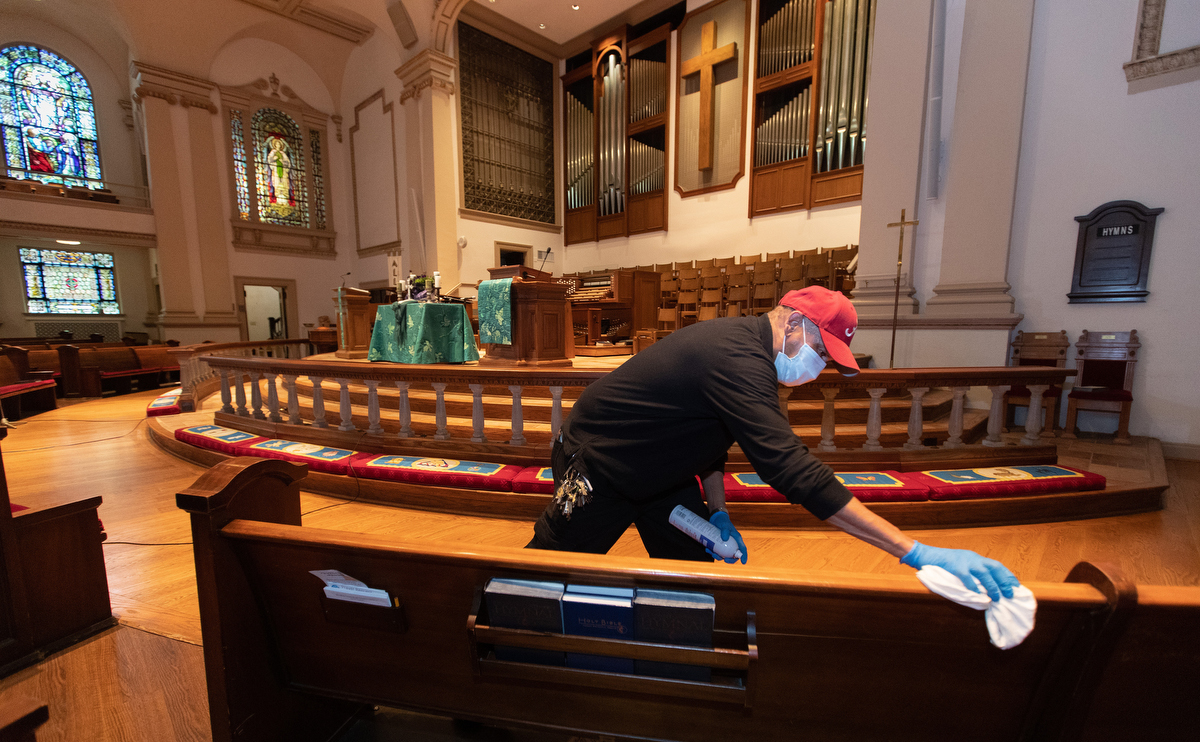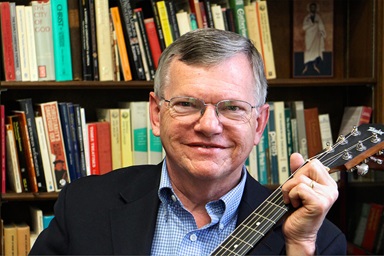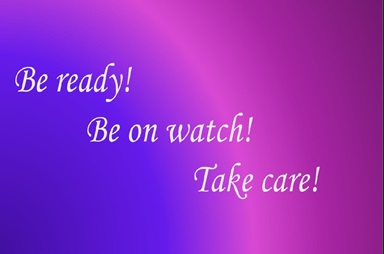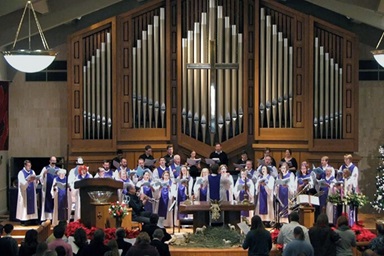On May 10, 30 congregants and nine church staff met in the sanctuary at First United Methodist Church in Poplar Bluff, Missouri, for their first in-person worship since the coronavirus outbreak put a stop to such gatherings.
It was quite different from the 250 who typically worship at the church’s three Sunday services. Everyone sat three pews apart and the normally large choir was reduced to a quartet, but the Rev. David Stewart, lead pastor, called it “an encouraging baby step.”
“One person told me, ‘I didn’t know how much I missed worshipping together until I did it again,’” he said.
The rise of the coronavirus pandemic and the social distancing measures that came with it forced churches to transition to online worship and ministry. Now, as many states lift shelter-in-place orders, churches must contemplate how — or whether — to return to in-person worship.
It’s not as simple as just staying six feet away. Corporate worship contains physical contact, from passing the peace to passing the collection plate, from the coffee machine to communion. Finding alternatives to certain acts and adhering to thorough cleaning and disinfecting measures will be a challenge.
Resources for churches
Ken Braddy blog: “24 Questions Your Church Should Answer Before People Return”
“Best Practices for Church Cleaning and Management,” by Larry Johnson, Oregon-Idaho Conference disaster preparedness and response coordinator
The South Georgia Conference: “Getting Ready to Return”
Minnesota Conference: Guidance for returning to in-person worship
Candler School of Theology helped start the Facebook group Ecumenical Protocols for Worship, Fellowship and Sacramental Practices, which is hosting webinars on its page every Tuesday at 10 a.m. CDT beginning May 12. The first webinar will deal with safely moving people in and out of the worship space as well as cleaning procedures.
Check your own conference website for potential guidelines or resources specific to your area. Click here for a directory of annual conferences.
“Best Practices for Church Cleaning and Management,” by Larry Johnson, Oregon-Idaho Conference disaster preparedness and response coordinator
The South Georgia Conference: “Getting Ready to Return”
Minnesota Conference: Guidance for returning to in-person worship
Candler School of Theology helped start the Facebook group Ecumenical Protocols for Worship, Fellowship and Sacramental Practices, which is hosting webinars on its page every Tuesday at 10 a.m. CDT beginning May 12. The first webinar will deal with safely moving people in and out of the worship space as well as cleaning procedures.
Check your own conference website for potential guidelines or resources specific to your area. Click here for a directory of annual conferences.
The Rev. Allen Cason, pastor of Metter United Methodist Church in Metter, Georgia, estimates it will be “five to 10 times as much work” for his church to hold in-person worship.
“We’d have to have multiple services and see if we have enough volunteers to do the necessary cleaning between each service. And whether we can acquire enough cleaning supplies at a reasonable price,” he said.
“Ultimately, does it still resemble worship once we put all these restrictions in place?”
The Rev. Susan Kent, pastor of women’s ministry and worship at The Woodlands United Methodist Church in The Woodlands, Texas, also expressed concern about over-regulating the community experience of church.
“If there’s no coffee time, if we can’t open our cafe, if there’s no fellowship, then we’ve sterilized the gathering,” she said.
With two campuses and more than 14,000 members, The Woodlands church would be hard-pressed to add enough additional services to accommodate limits on the number of people currently allowed at a gathering. Kent said the church doesn’t favor that approach anyway, and has no timetable for opening.
“I’ve seen churches looking at multiple services with a reservation system, but making reservations feels like ‘members only’ and that’s not what we’re about,” she said. “We don’t want to rush opening the doors if it means we have to turn people away.”
Cason said he’s surveying church members asking what measures they’re willing to take in order to have in-person worship, including wearing masks and having their temperature taken, or feeling comfortable leaving their children in the nursery.
Kelly Roberson, communications director for the South Georgia Conference, said in a May 5 conference webinar on reopening preparation that church leaders need to let everyone in the congregation know what’s happening.
“Tell them what steps you’ve taken and what’s expected of them as well. Explain what you are doing and why you’re not doing other things right now,” she said.
From the beginning of the pandemic, United Methodist bishops began issuing directives for churches in their episcopal areas to suspend in-person worship. Many extend past dates when their state governments are planning to relax quarantine measures.
In the Greater Northwest Episcopal Area, where many states are reopening or loosening restrictions, Bishop Elaine JW Stanovsky has asked churches not to gather in person through May 30. She cited John Wesley’s principle to “do no harm” as her guidance.
“As Christians and citizens committed to protecting public health, we are responsible both to abide by the guidance of government and health officials, and to assess whether the church holds itself to a higher standard of caution than the states direct,” she wrote in her April 24 bishop’s letter.
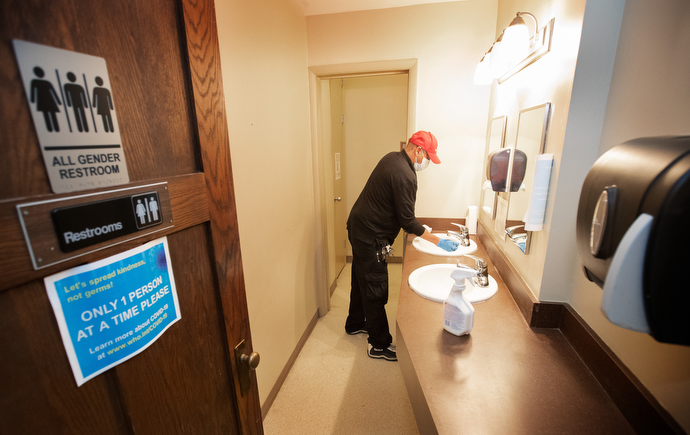
Custodian James Jimmerson disinfects a bathroom to prevent any possible spread of the coronavirus at Belmont United Methodist Church in Nashville, Tenn., on Sunday, May 10, 2020, after online worship, which was recorded in the sanctuary. “These bathrooms are the custodians’ pride and joy,” he said. Photo by Mike DuBose, UM News.
On April 28, Bishops Robert T. Hoshibata, Desert Southwest Conference, and Minerva G. Carcaño, California-Nevada Conference, joined Nevada leaders of the Evangelical Lutheran Church in America in a letter urging Nevada Gov. Steve Sisolak to extend the state’s stay-at-home directive, which was set to expire April 30. Sisolak has extended the order through May 15.
In Eastern Pennsylvania, Bishop Peggy Johnson encouraged churches in her episcopal area to follow the guidance of their county health departments, as the state of Pennsylvania is operating on a phased reopening that began May 8.
Bethany United Methodist Church in Milton, Pennsylvania, is in a part of the state cleared for small gatherings, so it held its first in-person worship since March 15. Attendees had to maintain distance and wear gloves, and communion was offered in pre-packaged, individual, sealed cups.
“I hate to use the term ‘new normal.’ There is nothing normal about this,” the church’s pastor, the Rev. William McNeal told The Daily Item newspaper.
Webinar maps out road to reopening
The Woodlands United Methodist Church is hosting a webinar, “Road to Reopening The UMC,” on Wednesday, May 13, at 2 p.m. CDT. The hour-long panel discussion will cover a wide variety of topics churches must consider as they look to worship in person again.
Panelists include the Rev. Adam Hamilton, United Methodist Church of the Resurrection, Leawood, Kan.; the Rev. Olu Brown, Impact Church, Atlanta; the Rev. Tom Berlin, Floris United Methodist Church, Herndon, Virginia; and the Revs. Ed Robb and Susan Kent from The Woodlands.
“So many churches currently lack a sounding board for their questions,” said Kent. “We are our best when we’re able to talk to others who could give new perspective or new ideas.”
Kent, The Woodlands’ pastor of women’s ministry and worship, said the idea came about when she shared information she’d gleaned from other webinars with Robb, the senior pastor, and he asked if such a gathering specific to the denomination had been held.
“We thought it would be good to have an open forum with people who have similar grounding in sacraments and other aspects of worship and ministry,” she said.
Registrants to the event may submit questions to the panel in advance.
To register, visit thewoodlandsumc.org/reopen.
Panelists include the Rev. Adam Hamilton, United Methodist Church of the Resurrection, Leawood, Kan.; the Rev. Olu Brown, Impact Church, Atlanta; the Rev. Tom Berlin, Floris United Methodist Church, Herndon, Virginia; and the Revs. Ed Robb and Susan Kent from The Woodlands.
“So many churches currently lack a sounding board for their questions,” said Kent. “We are our best when we’re able to talk to others who could give new perspective or new ideas.”
Kent, The Woodlands’ pastor of women’s ministry and worship, said the idea came about when she shared information she’d gleaned from other webinars with Robb, the senior pastor, and he asked if such a gathering specific to the denomination had been held.
“We thought it would be good to have an open forum with people who have similar grounding in sacraments and other aspects of worship and ministry,” she said.
Registrants to the event may submit questions to the panel in advance.
To register, visit thewoodlandsumc.org/reopen.
Once churches reopen, they will have to ponder what their post-coronavirus ministry will look like.
Many have found success in virtual worship, and even have attracted “parishioners” from other parts of the country. They may be hesitant to cease a vibrant online ministry when in-person services resume.
“Even though it’s not what everyone wants, what we’re doing now is working,” Cason said, adding that giving at his church increased in March.
Johnson urged her congregations to keep it up. In a recent e-newsletter to the Eastern Pennsylvania Conference, she wrote, “Please continue to offer your wonderful online presence to the world that is your parish. We can never go back to the days of in-person, onsite worship only.”
Without additional support, scheduling both personal and virtual ministry could prove troubling to pastors who may have already been overworked and under-resourced before the pandemic.
West Ohio Conference Bishop Gregory Palmer said it may be necessary to prioritize and adapt ministry going forward.
In the conference e-newsletter, he wrote, “Make no mistake: We will be doing some old things in new ways, and we will not be doing some things at all.”
During an Arkansas Conference webinar on relaunching worship, the Rev. Todd Lovell, associate pastor of First United Methodist Church in Springdale, Arkansas, said the current situation is a good time for church leaders to evaluate what’s essential to their ministry.
“COVID-19 could allow churches to hit the reset button on our identity, to start ministries we’ve always wanted to and end others,” he said. “This is a good opportunity to rid ourselves of ‘legacy’ programs that the church has always done but may no longer support the mission.”
Lovell even uttered what could be considered blasphemy by many United Methodists: “We can still be a church if we don’t have potlucks.”
For now, Cason said he’s envisioning a first step back as the “Acts 2 house church model” where small groups will gather in each other’s homes to watch worship online and hold discussion afterward.
His bishop agrees.
On a May 4 Zoom meeting about the South Georgia Conference’s “rolling restart” plans, Bishop R. Lawson Bryan said, “Small groups will be the first step. This is what Methodists have been saying for 250 years: Christians grow best in small groups.”
Butler is a multimedia editor for UM News. Contact him at 615-742-5470 or [email protected]. To read more United Methodist news, subscribe to the free daily or weekly digests.
Like what you're reading? Support the ministry of UM News! Your support ensures the latest denominational news, dynamic stories and informative articles will continue to connect our global community. Make a tax-deductible donation at ResourceUMC.org/GiveUMCom.

